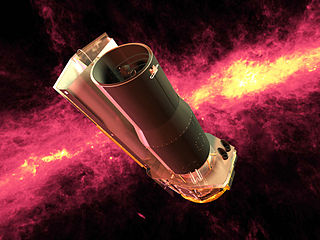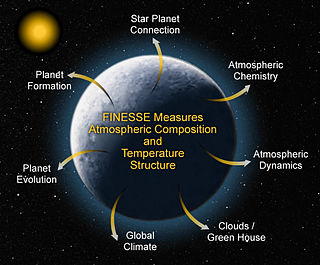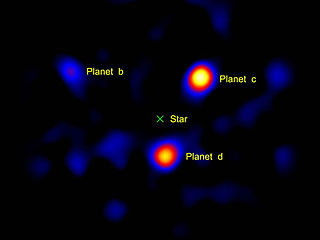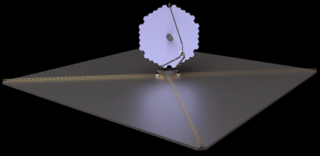Related Research Articles

Subaru Telescope is the 8.2-meter (320 in) flagship telescope of the National Astronomical Observatory of Japan, located at the Mauna Kea Observatory on Hawaii. It is named after the open star cluster known in English as the Pleiades. It had the largest monolithic primary mirror in the world from its commissioning until 2005.

The Spitzer Space Telescope, formerly the Space Infrared Telescope Facility (SIRTF), is a retired infrared space telescope launched in 2003 and retired on 30 January 2020.

A coronagraph is a telescopic attachment designed to block out the direct light from a star so that nearby objects – which otherwise would be hidden in the star's bright glare – can be resolved. Most coronagraphs are intended to view the corona of the Sun, but a new class of conceptually similar instruments are being used to find extrasolar planets and circumstellar disks around nearby stars as well as host galaxies in quasars and other similar objects with active galactic nuclei (AGN).

The Center for Astrophysics | Harvard & Smithsonian (CfA) is an astrophysics research institute jointly operated by the Harvard College Observatory and Smithsonian Astrophysical Observatory. Founded in 1973 and headquartered in Cambridge, Massachusetts, the CfA leads a broad program of research in astronomy, astrophysics, Earth and space sciences, as well as science education. The CfA either leads or participates in the development and operations of more than fifteen ground- and space-based astronomical research observatories across the electromagnetic spectrum, including the forthcoming Giant Magellan Telescope (GMT) and the Chandra X-ray Observatory, one of NASA's Great Observatories.

The New Worlds Mission is a proposed project comprising a large occulter flying in formation designed to block the light of nearby stars in order to observe their orbiting exoplanets. The observations could be taken with an existing space telescope, possibly the James Webb Space Telescope when it launches, or a dedicated visible light optical telescope optimally designed for the task of finding exoplanets. A preliminary research project was funded from 2005 through 2008 by NASA Institute for Advanced Concepts (NIAC) and headed by Webster Cash of the University of Colorado at Boulder in conjunction with Ball Aerospace & Technologies Corp., Northrop Grumman, Southwest Research Institute and others. Since 2010 the project has been looking for additional financing from NASA and other sources in the amount of roughly US$3 billion including its own four-meter telescope, or $750 million for one starshade to be used with the James Webb Space Telescope. If financed and launched, it would operate for five years.

Konkoly Observatory is an astronomical observatory located in Budapest, Hungary is part of the Research Centre for Astronomy and Earth Sciences and belongs to the Eötvös Loránd Kutatási Hálózat. It was founded in 1871 by Hungarian astronomer Miklós Konkoly-Thege (1842–1916) as a private observatory, and was donated to the state in 1899. Konkoly Observatory, officially known as ELKH CSFK Konkoly Thege Miklós Csillagászati Intézet in Hungarian, is the largest astronomical research institute in Hungary, and hosts the largest telescopes in the country. The Observatory has more than 60 researchers, a quarter of them are non-Hungarian.

The Apollo Telescope Mount, or ATM, was a crewed solar observatory that was a part of Skylab, the first American space station. It could observe the Sun in wavelengths ranging from soft X-rays, ultra-violet, and visible light.

Epsilon Eridani b, also known as Ægir, is an exoplanet approximately 10.5 light-years away orbiting the star Epsilon Eridani, in the constellation of Eridanus. The planet was discovered in 2000, and as of 2019 remains the only confirmed planet in its planetary system. It orbits at around 3.5 AU with a period of around 7.4 years, and has a mass around 1.2 times that of Jupiter.

Heidi B. Hammel is a planetary astronomer who has extensively studied Neptune and Uranus. She was part of the team imaging Neptune from Voyager 2 in 1989. She led the team using the Hubble Space Telescope to view Shoemaker-Levy 9's impact with Jupiter in 1994. She has used the Hubble Space Telescope and the Keck Telescope to study Uranus and Neptune, discovering new information about dark spots, planetary storms and Uranus' rings. In 2002, she was selected as an interdisciplinary scientist for the James Webb Space Telescope.

The Space Infrared Telescope for Cosmology and Astrophysics (SPICA), was a proposed infrared space telescope, follow-on to the successful Akari space observatory. It was a collaboration between European and Japanese scientists, which was selected in May 2018 by the European Space Agency (ESA) as a finalist for the next Medium class Mission 5 of the Cosmic Vision programme, to launch in 2032. The other 2 finalists are: THESEUS and EnVision. SPICA will improve on the spectral line sensitivity of previous missions, the Spitzer and Herschel space telescopes, between 30 and 230 µm by a factor of 50—100.

The Gemini Planet Imager (GPI) is a high contrast imaging instrument that was built for the Gemini South Telescope in Chile. The instrument achieves high contrast at small angular separations, allowing for the direct imaging and integral field spectroscopy of extrasolar planets around nearby stars. The collaboration involved in planning and building the Gemini Planet imager includes the American Museum of Natural History (AMNH), Dunlap Institute, Gemini Observatory, Herzberg Institute of Astrophysics (HIA), Jet Propulsion Laboratory, Lawrence Livermore National Lab (LLNL), Lowell Observatory, SETI Institute, The Space Telescope Science Institute (STSCI), the University of Montreal, University of California, Berkeley, University of California, Los Angeles (UCLA), University of California, Santa Cruz (UCSC), University of Georgia.

The Nancy Grace Roman Space Telescope is a NASA infrared space telescope currently under development. Roman was recommended in 2010 by the United States National Research Council Decadal Survey committee as the top priority for the next decade of astronomy. On February 17, 2016, WFIRST was approved for development and launch.

Fast Infrared Exoplanet Spectroscopy Survey Explorer (FINESSE) was a NASA mission proposal for a space observatory operating in the Near-infrared spectrum for the Medium-Class Explorers program. The Principal Investigator was Mark Swain of the Jet Propulsion Laboratory in Pasadena, California.

A vortex coronagraph is a type of optical instrument which enables the imaging of very faint objects near very bright objects that would normally be obscured by glare. For example, extrasolar planets near their host star as seen from Earth or space telescopes in Earth's solar system. It is a type of coronagraph.
Exoplanetary Circumstellar Environments and Disk Explorer(EXCEDE) is a proposed space telescope for NASA's Explorer program to observe circumstellar protoplanetary and debris discs and study planet formation around nearby stars of spectral classes M to B. Had it been selected for development, it was proposed to launch in 2019.

The Large Ultraviolet Optical Infrared Surveyor, commonly known as LUVOIR, is a multi-wavelength space telescope concept being developed by NASA under the leadership of a Science and Technology Definition Team. It is one of four large astrophysics space mission concepts being studied in preparation for the National Academy of Sciences 2020 Astronomy and Astrophysics Decadal Survey. While LUVOIR is a concept for a general-purpose observatory, it has the key science goal of characterizing a wide range of exoplanets, including those that might be habitable. An additional goal is to enable a broad range of astrophysics, from the reionization epoch, through galaxy formation and evolution, to star and planet formation. Powerful imaging and spectroscopy observations of Solar System bodies would also be possible. LUVOIR would be a Large Strategic Science Mission and will be considered for a development start sometime after 2020. The LUVOIR Study Team has produced designs for two variants of LUVOIR: one with a 15.1 m diameter telescope mirror (LUVOIR-A) and one with an 8 m diameter mirror (LUVOIR-B). LUVOIR can observe ultraviolet, visible, and near-infrared wavelengths of light. The Final Report on the 5-year LUVOIR mission concept study was publicly released on 26 August 2019.
The Habitable Exoplanet Observatory (HabEx) is a space telescope concept that would be optimized to search for and image Earth-size habitable exoplanets in the habitable zones of their stars, where liquid water can exist. HabEx would aim to understand how common terrestrial worlds beyond the Solar System may be and determine the range of their characteristics. It would be an optical, UV and infrared telescope that would also use spectrographs to study planetary atmospheres and eclipse starlight with either an internal coronagraph or an external starshade.

Origins Space Telescope (Origins) is a concept study for a Far-Infrared Surveyor space telescope mission. A preliminary concept in pre-formulation, it was presented to the United States Decadal Survey in 2019 for a possible selection to NASA's large strategic science missions. Origins would provide an array of new tools for studying star formation and the energetics and physical state of the interstellar medium within the Milky Way using infrared radiation and new spectroscopic capabilities.
Cosmic Vision is the third campaign of space science and space exploration missions in the Science Programme of the European Space Agency (ESA). Formulated in 2005 as Cosmic Vision: Space Science for Europe 2015–2025, the campaign succeeded the Horizon 2000 Plus campaign and envisioned a number of missions in the fields of astronomy and solar system exploration beyond 2015. Ten missions across four funding categories are planned to be launched under Cosmic Vision, with the first being CHEOPS in December 2019. A mission to the Galilean moons (JUICE), the first deep space mission with an opportunistic target, and one of the first gravitational-wave space observatories (LISA), are planned for launch as part of the Cosmic Vision campaign.
References
- ↑ universe.nasa.gov Archived April 25, 2012, at the Wayback Machine [Retrieved 2011-10-30]
- ↑ nspires.nasaprs.com Actively Corrected Coronagraph Exoplanet System Studies [Retrieved 2011-10-30]
- ↑ Yale University & Zooniverse ( homepage) || planethunters.org search for exoplants from data released by the NASA Kepler mission open to public participation Retrieved 2011-12-24]
- ↑ Cash, Webster oai.dtic.mil Archived 2012-04-18 at the Wayback Machine The New Worlds Observer: The Astrophysics Strategic Mission Concept StudyNAVAL OBSERVATORY WASHINGTON DC AUG 2009DTIC online [Retrieved 2011-12-23] (2011-10-30)
- ↑ newworlds.colorado.edu CASA at the University of Colorado [Retrieved 2011-12-23]
- ↑ exep.jpl.nasa.gov [Retrieved 2011-10-30] (2011-12-24)
- ↑ EPIC [Retrieved 2011-10-30] (2011-12-24)
- ↑ XPC [Retrieved 2011-10-30] (2011-12-24)
- ↑ (this link is including ten selected publications by J.Trauger) NASA people + heritage.stsci.edu [Retrieved 2011-12-24]
- ↑ ACCESS [Retrieved 2011-10-30] (2011-12-24)
- ↑ jpl.nasa.gov Archived January 4, 2012, at the Wayback Machine [Retrieved 2011-11-24]
- ↑ PECO [Retrieved 2011-10-30] (2011-12-24)
- ↑ DAViNCI [Retrieved 2011-10-30] (2011-12-24)
- ↑ hea-www.harvard.edu Retrieved 2011-10-30
- ↑ Grindlay, Jonathan; Team, the EXIST (2009). "GRB Probes of the High-z Universe with EXIST". AIP Conference Proceedings. 1133: 18–24. arXiv: 0904.2210 . Bibcode:2009AIPC.1133...18G. doi:10.1063/1.3155875. S2CID 118082356.
- ↑ Lazio, T. Joseph W.; Burns, J.; Jones, D.; Kasper, J.; Neff, S.; MacDowall, R.; Weiler, K.; DALI/ROLSS Team (2009-01-01). "The Dark Ages Lunar Interferometer (DALI) and the Radio Observatory for Lunar Sortie Science (ROLSS)". American Astronomical Society Meeting Abstracts #213. 213: 451.02. Bibcode:2009AAS...21345102L.
- STSI [Retrieved 2011-10-30]